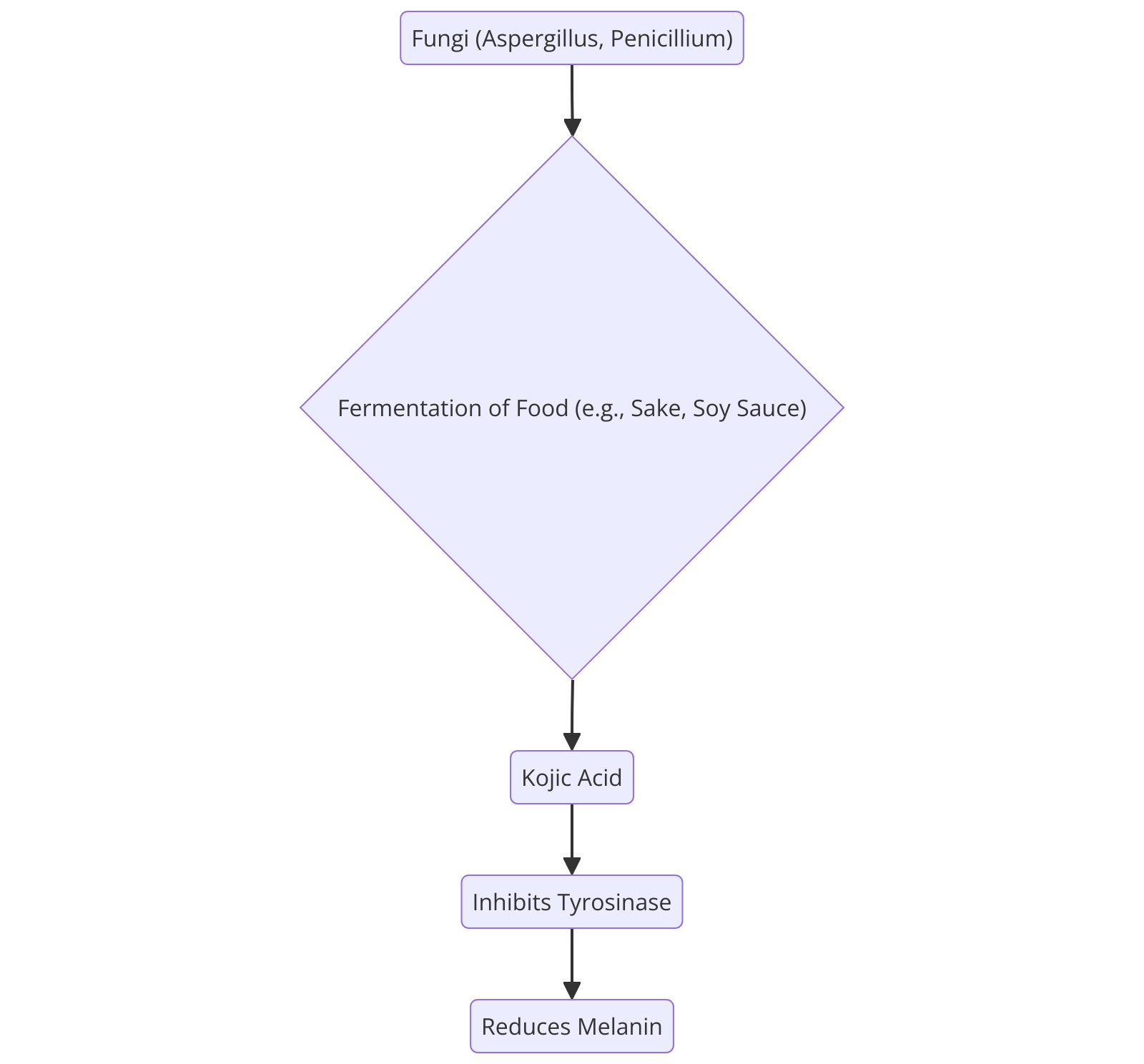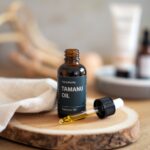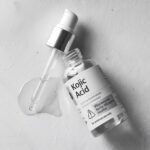- Kojic acid works by inhibiting the enzyme tyrosinase, which reduces melanin production and lightens skin.
- Kojic acid is used to treat hyperpigmentation, dark spots, melasma, and uneven skin tone.
- Potential side effects may include irritation, redness, and increased sun sensitivity, especially with prolonged use.
- Alternatives to kojic acid include vitamin C, alpha arbutin, and azelaic acid for skin brightening.
What is Kojic Acid?
Kojic acid is a natural compound known for its skin-lightening properties. It’s derived from fungi during the fermentation of foods like sake, soy sauce, and rice wine. Kojic acid acts as a tyrosinase inhibitor, which blocks melanin production. This makes it popular in cosmetics for treating hyperpigmentation, age spots, and skin discoloration.
Go All Natural: 88 Natural Skin Care Ingredients You Already Have at Home
Kojic acid is produced through the fermentation of specific fungi, particularly those from the Aspergillus genus. During this process, carbohydrates break down into alcohol, which is then converted into kojic acid. This can also happen during the fermentation of foods like sake and soy sauce, where fungi enzymes are essential.

The Benefits of Kojic Acid
Kojic acid is becoming a go-to solution for treating hyperpigmentation and enhancing skin appearance. Below are the key benefits of kojic acid, all backed by research:
Skin Lightening and Hyperpigmentation Treatment
Kojic acid may lighten skin and reduce hyperpigmentation, including dark spots, melasma, and age spots. It works by inhibiting tyrosinase, the enzyme essential for melanin production. By blocking this enzyme, kojic acid lowers melanin synthesis, creating a more even skin tone. Studies support its effectiveness. Patients using a 1% kojic acid cream saw skin color improvement over six months, particularly in melasma cases.
Comparing Top 5 Kojic Acid Products for Glowing, Even Skin
Antioxidant Properties
Kojic acid shields the skin from oxidative stress caused by UV rays and pollution. Antioxidants help neutralize free radicals that contribute to premature aging and skin damage. Research suggests kojic acid helps repair skin cells from these damaging effects, resulting in healthier-looking skin.
Anti-Inflammatory Effects
Kojic acid has anti-inflammatory properties that soothe irritation and redness. This makes it ideal for conditions like acne or rosacea.
Improvement of Scars and Sun Damage
Kojic acid is effective in lightening scars and sun damage, leading to an overall improvement in skin texture. While it doesn’t change scar thickness, it can lighten dark pigmentation associated with scars.
How Kojic Acid Works on Skin
Kojic acid works by blocking an enzyme called tyrosinase, which is key to making melanin. This helps lighten areas of hyperpigmentation, like age spots, melasma, and post-acne marks, making it useful in skincare for brightening and evening skin tone.
kojic acid also offers antioxidant and anti-inflammatory properties that protect your skin from damage caused by pollution and UV rays. It also has antimicrobial properties, making it helpful in fighting acne and preventing certain fungal infections.
Top Benefits of Kojic Acid for Skin Health
Studies have shown that using kojic acid regularly can lead to clearer, brighter skin in just a few weeks. Most products use between 1% to 2%, as higher amounts can cause irritation, especially for sensitive skin. When combined with other ingredients like glycolic acid, kojic acid can work even better.
How to Safely Use Kojic Acid in Your Skincare Routine: A Step-by-Step Guide
Kojic Acid in Skincare Products
You can find it in serums, which are great if you want targeted treatment for specific areas, like dark spots. Serums tend to have higher concentrations of active ingredients, making them super effective. lotions and creams offer a more diluted version of Kojic, perfect for all-over use if you’re aiming for a more even skin tone. And finally there are kojic soaps, which are convenient if you want a more gentle, gradual effect.
The Growing Popularity of Kojic Acid in Beauty Products
Concentrations of Kojic Acid in Products (What’s Safe?)
For kojic acid, the safe and effective concentration ranges between 1% to 4%. Products with concentrations at the lower end are ideal for beginners or those with sensitive skin. Higher concentrations can be reserved for more targeted treatments, like reducing stubborn pigmentation. Always keep in mind that using kojic acid over a long period or in very high doses can lead to skin sensitivity,.
Kojic Acid Combined with Other Skincare Ingredients
Pairing kojic acid with other skincare ingredients can amplify its benefits! For example, combining it with Vitamin C helps brighten the skin, as both ingredients work synergistically to even out your skin tone. Retinoids, on the other hand, help with cell turnover, making it easier for kojic acid to fade dark spots more effectively.
How Kojic Acid is Used Around the World
Who Should Use Kojic Acid?
Kojic acid is helpful for darker skin tones, as it targets excess melanin production, which can cause uneven skin tone. If you have normal to oily skin, kojic acid could improve your complexion without causing major side effects. Many people also choose it as a gentler, more natural alternative to stronger lightening agents like hydroquinone.
If you have sensitive skin or conditions like eczema or rosacea, kojic acid might be too harsh, causing redness or irritation. Pregnant or breastfeeding women should also consult their healthcare provider before trying kojic acid, as its safety in these stages isn’t fully clear. If your skin is sunburnt or broken, it’s best to hold off on kojic acid until your skin heals since it can make irritation worse.
Kojic Acid for Hyperpigmentation
Kojic acid is a well-researched ingredient known for its ability to tackle hyperpigmentation. Its magic lies in its role as a tyrosinase inhibitor. Tyrosinase is the key enzyme that helps convert the amino acid tyrosine into melanin, the pigment responsible for your skin color. This slows down melanin production, leading to a lighter and more even skin tone. The effect has been backed by several studies, showing that kojic acid can reduce melanin levels in skin cells and in models of hyperpigmentation.
Kojic acid also offers antioxidant benefits, which add to its skin-brightening power. Antioxidants help fight oxidative stress from free radicals, which can worsen pigmentation and speed up skin aging. Combining kojic acid with exfoliating ingredients like glycolic acid can boost its effectiveness, helping to fade dark spots.
Kojic Acid for Skin Brightening
Kojic acid works by blocking tyrosinase, the enzyme responsible for producing melanin, which gives skin its color. With reduced melanin production, kojic acid helps create a lighter and more even skin tone.
In one study, participants who used kojic acid saw improvements in skin brightness and tone. About 75% experienced brighter skin, while 83% noticed a more even complexion with reduced discoloration. Although kojic acid is generally safe for most skin types, it’s best to use it at concentrations below 1% to avoid irritation or sensitivity. Overall, kojic acid is effective if you want to fade dark spots, even out skin tone, and achieve a brighter complexion.
Kojic Acid for Anti-Aging
kojic acid may help reduce common signs of aging, particularly through its impact on pigmentation and oxidative stress. One of the key ways kojic acid fights aging is by blocking melanin production. It does this by stopping the enzyme tyrosinase, which is essential for making melanin. The reduction in melanin helps lighten dark spots like age spots and sun damage, which are common signs of aging.
Kojic Acid for Acne and Acne Scars
While kojic acid is known for treating melasma and sunspots, it’s also great for addressing acne scars, especially those that have become dark or discolored.
How Kojic Acid Helps with Acne Scars
Lightens Hyperpigmentation
Acne scars, especially inflamed or infected ones, can lead to excess melanin production, resulting in post-inflammatory hyperpigmentation (PIH). Kojic acid reduces melanin levels, helping to fade these dark marks and create a more even skin tone.
Gently Exfoliates
Kojic acid also has mild exfoliating properties, helping to slough off dead skin cells from the surface. This reveals fresher, brighter skin underneath, giving your complexion a smoother, more even look.
Boosts Collagen Production
Some studies suggest that kojic acid may stimulate collagen production, which helps improve the appearance of acne scars. Collagen can plump and smooth the skin, making scars less noticeable over time.
Side Effects and Risks of Kojic Acid
One side effect of kojic acid is contact dermatitis, which can cause redness, irritation, rashes, and discomfort. People with sensitive skin and those using higher concentrations than recommended are more likely to experience these reactions. Symptoms might include itching, dry patches, or, in severe cases, pain and blistering.
Another concern with kojic acid is that it can make your skin more sensitive to sunlight. Since it reduces melanin (the pigment that helps protect against UV damage), your skin may become more prone to sunburn.
Long-term use can lead to increased skin sensitivity, so it’s essential to follow usage guidelines carefully. Dermatologists often suggest starting with lower concentrations (around 1-2%) and only increasing to higher levels (up to 4%) if your skin tolerates it well. Kojic acid should never be applied to broken or damaged skin, as this can worsen irritation.
Alternatives to Kojic Acid
While kojic acid may treat hyperpigmentation, there are alternatives that may serve the same purpose. Always consider your skin’s unique needs and consult with a dermatologist to find the best solution for your specific skincare goals.
Vitamin C (Ascorbic Acid)
Vitamin C ,may brighten skin and reduce hyperpigmentation. It inhibits tyrosinase, the enzyme responsible for melanin production, similar to kojic acid. Vitamin C is particularly effective at brightening dull skin, evening out skin tone.
Alpha Arbutin
Alpha arbutin is a natural derivative of hydroquinone but much gentler. It also targets tyrosinase to reduce melanin production. Alpha arbutin is an alternative for people with sensitive skin or those who want to avoid the stronger effects of hydroquinone. Alpha arbutin may help fade out sun spots, age spots, and post-inflammatory hyperpigmentation. Unlike hydroquinone, it poses a lower risk of side effects like irritation or skin darkening (a condition known as ochronosis).
Niacinamide (Vitamin B3)
Niacinamide not only brightens skin but also strengthens the skin barrier and reduces inflammation. It works by interfering with the transfer of melanin to skin cells, thereby preventing dark spots from forming. In addition to brightening, niacinamide helps regulate oil production, soothes irritated skin, and improves the overall texture. It’s well-tolerated by most skin types, making it a great option for daily use.
Licorice Root Extract
Licorice root extract contains glabridin, a compound that inhibits tyrosinase, preventing melanin production. It has anti-inflammatory properties, which makes it particularly useful for calming irritated skin. The natural ingredient may lighten dark spots and soothe redness. it is best for sensitive or irritated skin that requires both brightening and calming properties.
Azelaic Acid
Azelaic acid is a naturally occurring acid found in grains like barley and wheat. It inhibits tyrosinase and reduces melanin production, but it can also target acne-causing bacteria and reduce inflammation. The acid is particularly effective for people with acne-prone skin. Its anti-inflammatory and antibacterial properties make it a unique dual-purpose treatment for hyperpigmentation and acne.
Tranexamic Acid
Tranexamic acid works by inhibiting the plasminogen/plasmin pathway, which leads to a decrease in the inflammatory mediators that contribute to hyperpigmentation. It is particularly effective in treating melasma, one of the most stubborn forms of pigmentation. Tranexamic acid is best for stubborn pigmentation, particularly melasma, and other hormone-related dark spots.
Retinoids (Retinol, Tretinoin)
Retinoids work differently from the other ingredients by speeding up cell turnover rather than directly inhibiting melanin production. By encouraging faster skin regeneration, retinoids help shed the outer layers of skin, leading to a reduction in hyperpigmentation over time. However, they can be irritating, especially for first-time users, so it’s important to start with lower strengths.
Kojic Acid in Body Care
Kojic acid is most often associated with facial skincare, but its brightening properties make it a great option for body care, too.
Kojic Acid for Body Brightening
if you want to brightening the skin on larger areas of the body, kojic acid works similarly to how it does on the face. it inhibits the enzyme tyrosinase, which reduces melanin production.
How to use it:
- Look for kojic acid in body lotions, creams, or serums with concentrations ranging from 1-2%.
- Apply it to areas of concern once daily, preferably at night, to help reduce dark patches and promote a more even tone.
- Don’t forget to use sunscreen on treated areas during the day, as kojic acid increases sun sensitivity, even on the body.
| Ingredient | Effectiveness | Concentration Range | Potential Side Effects | Ideal Skin Types |
|---|---|---|---|---|
| Kojic Acid | Slower results but effective for melasma and dark spots | 1-4% | May cause irritation, contact dermatitis | All skin types, especially sensitive skin |
| Hydroquinone | Fastest for severe pigmentation (e.g., melasma) | 2-4% (prescription up to 10%) | Can cause redness, irritation, ochronosis (rare) | Oily, acne-prone, but avoid long-term use |
| Vitamin C | Brightens skin and fades sun damage | 10-20% | May irritate sensitive skin at high concentrations | Normal to oily skin; avoid if very sensitive |
| Alpha Arbutin | Gradual and gentler than hydroquinone | 1-2% | Minimal irritation, less potent than hydroquinone | Sensitive skin, effective for gradual lightening |
Sources: Byrdie on Kojic Acid, Admire My Skin on Alpha Arbutin
Is Kojic Acid Safe for Sensitive Areas?
Using kojic acid on sensitive areas, such as the underarms, inner thighs, or intimate regions, requires caution. These areas tend to have thinner skin and are more prone to irritation.
Tips for sensitive areas:
- Start with a product that has a low concentration (around 1%) to minimize the risk of irritation.
- Perform a patch test before applying it to larger areas to ensure your skin can tolerate it.
- Use kojic acid sparingly in these areas and avoid broken or irritated skin, as it could worsen sensitivity or cause discomfort.
Using Kojic Acid for Stretch Marks
While kojic acid may brighten dark spots and hyperpigmentation, it’s not as effective on stretch marks. Stretch marks are caused by the stretching of the skin, leading to tears in the dermis layer, which changes skin texture. Kojic acid can lighten the pigmentation of newer stretch marks, but it won’t have much of an effect on the texture or depth of the marks. Moisturizing ingredients like hyaluronic acid or shea butter can help improve the overall appearance of stretch marks as they keep the skin hydrated.
Kojic Acid in Body Lotions and Creams
Body lotions with kojic acid may help brighten and smooth areas that may have developed dark spots. Kojic acid increases effectiveness when combined with other ingredients like glycolic acid or niacinamide. Opt for lotions and creams with kojic acid concentrations between 1-2% for safe and effective body brightening.
Kojic Acid in Different Cultures
kojic acid was discovered in 1907 during the fermentation of rice for sake; it was initially noted for its antioxidant properties. Over time, it became popular in the beauty world for its ability to reduce melanin production.
The cosmetic market in the Asia-Pacific region dominates the global kojic acid industry, accounting for over 35% of its share in 2021. Countries like China and India are significant consumers of skincare products containing kojic acid.
Globally, the use of kojic acid has expanded beyond Asia. It is now a common ingredient in skincare formulations across North America and Europe. The compound’s effectiveness as an alternative to harsher skin-lightening agents like hydroquinone has contributed to its popularity. Kojic acid is incorporated into a wide range of products, including creams, lotions, powders, and cleansers.
In traditional medicine, kojic acid has been utilized to treat various skin conditions due to its antifungal and antibacterial effects.
What to Look for in Quality Kojic Acid Products
When choosing kojic acid products, pay attention to these factors to ensure you’re getting a safe and effective formulation. Here’s what to look for:
Concentration of Kojic Acid:
Most skincare products contain between 1-2% kojic acid, which is effective for brightening and treating hyperpigmentation. Higher concentrations may increase the risk of skin irritation.
Formulation with Stabilizers:
Kojic acid is unstable and can lose its potency when exposed to air and light. Look for products with stabilizers like antioxidants or those in opaque, airless packaging.
Complementary Ingredients:
A good kojic acid product wcombines with soothing or hydrating ingredients like hyaluronic acid, aloe vera, or niacinamide. These help minimize potential irritation and boost skin hydration, balancing kojic acid’s more active properties.
pH Level:
Kojic acid works best in a slightly acidic environment. Check for products with a pH level between 4 and 5, as this range enhances its ability to penetrate the skin without causing too much irritation.
Reputable Brand:
Opt for products from well-known, reputable brands that prioritize safety and quality. A brand that follows good manufacturing practices or offers transparency in sourcing ingredients is more likely to produce reliable products.
Frequently Asked Questions About Kojic Acid
What does kojic acid do to your skin?
Kojic acid is known for its skin-lightening properties, primarily due to its ability to inhibit melanin production. Melanin is the pigment responsible for the color of skin, hair, and eyes, and its production is stimulated by an enzyme called tyrosinase. Kojic acid acts as a tyrosinase inhibitor, effectively reducing melanin synthesis and leading to a lighter skin tone.
How long does it take for kojic acid to lighten skin?
The time it takes for kojic acid to lighten skin can vary based on an individual’s skin type, the severity of hyperpigmentation, and the frequency of use. Generally, users can expect to see noticeable results within 2 to 4 weeks of consistent application. However, for cases of severe dark spots or melasma, it may take up to 3 months or longer to achieve optimal results.
Skin Lightening: How Long Does Kojic Acid Take to Work?
Is kojic acid a bleaching agent?
Yes, kojic acid is considered a bleaching agent due to its ability to inhibit melanin production in the skin. It is often compared to hydroquinone, another well-known skin-lightening agent. However, kojic acid is generally regarded as less aggressive and safer for topical use.
What are the disadvantages of kojic?
One of the most common side effects is contact dermatitis, particularly in individuals with sensitive skin. Symptoms can include redness, irritation, rashes, itching, and pain. Kojic acid can also make the skin more sensitive to sunlight. Since it inhibits melanin production, users may find their skin becomes more susceptible to sunburn and damage. Some studies suggest that prolonged exposure may lead to skin irritation or even increase the risk of skin cancer on damaged skin.
What not to mix with kojic acid?
Using multiple skin-lightening agents simultaneously (such as hydroquinone or arbutin) alongside kojic acid can increase the risk of effects. It is best to use one active ingredient at a time to gauge its effectiveness and monitor for any side effects.
Conclusion: Is Kojic Acid Right for You?
Kojic acid may treat hyperpigmentation, sun damage, and uneven skin tone. Its ability to inhibit melanin production makes it an effective option for brightening and smoothing skin.
However, you should consider potential side effects like irritation and increased sun sensitivity. Starting with a lower concentration (1-2%) and combining it with soothing ingredients can help reduce the risk of irritation.

I’m a devoted organic skincare enthusiast, passionate about the natural, wholesome goodness that organic products bring to our skin.
Organic skincare isn’t just a hobby for me—it’s a lifestyle. Every product I use, recommend, and write about has been carefully chosen for its purity and effectiveness. Everything I write about is backed by scientific studies, dermatologists’ opinions, and user experiences.
I also excel at tackling skincare challenges with innovative, organic solutions.

